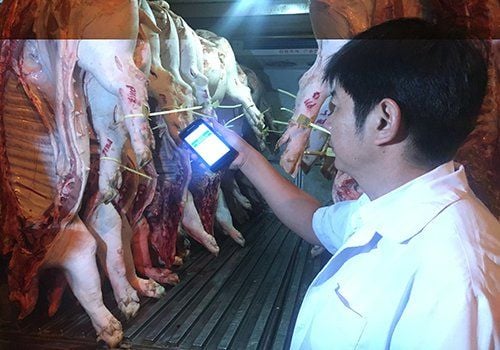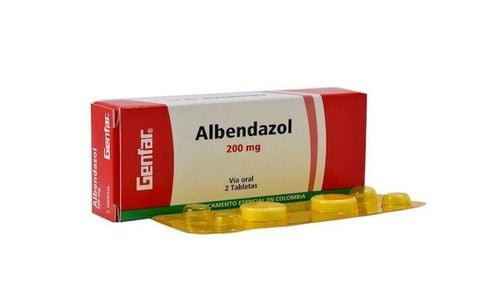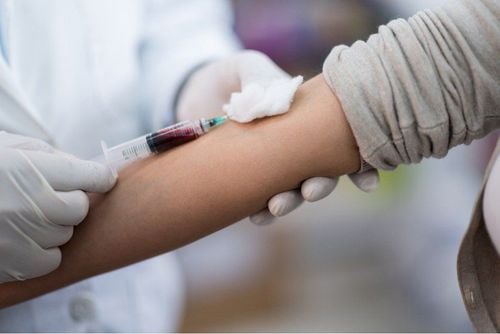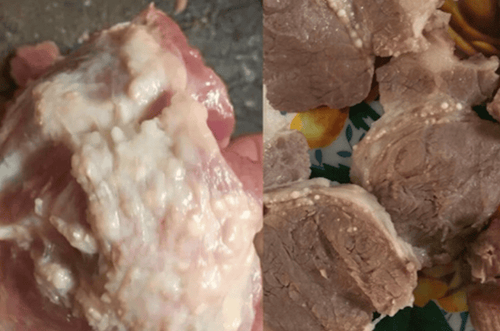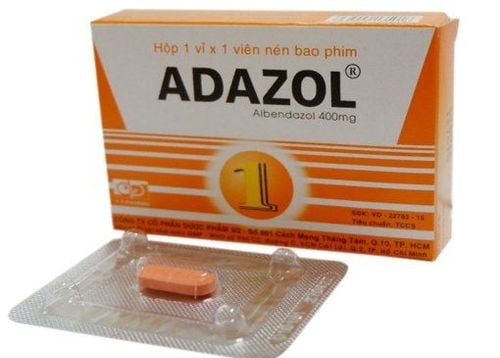This is an automatically translated article.
The article was professionally consulted with Doctor Vo Ha Bang Suong - Therapist - Department of Medical Examination & Internal Medicine - Vinmec Phu Quoc International General Hospital.When humans eat or swallow eggs, the eggs go into the stomach, then hatch into larvae and reach the small intestine, through the digestive tract wall into the bloodstream. About 4 to 8 weeks later, the larvae form a cyst with an outer shell, it is called rice fluke larvae because the cyst contains white fluid. Depending on the location of the cyst in the body, there are different symptoms and complications.
1. What is a pork tapeworm?
Tapeworms are a type of tapeworm (also known as tapeworm) with the scientific name Teania Solium.Pork fluke larval disease (also known as rice pig disease) with scientific name Cysticercus cellulosae, is a disease caused by larvae of pork fluke, which is different from the disease caused by adult flukes.
2. Where did I get the tapeworm from?
Tapeworm infection, or rice fluke, is a parasitic disease capable of infecting animals and humans. The main cause is from eating pork carrying fluke larvae or eating foods contaminated with larvae in soil and water (aquatic vegetables, raw vegetables not washed ..).Pig tapeworm larvae are present in the feces of humans or infected pigs. When hygiene is not ensured, the larvae will mix with vegetables, fruits, and water sources. Humans who use it without washing it thoroughly, cooking it will easily be infected with pork tapeworm.
According to the Department of Preventive Medicine, Ministry of Health, tapeworm larvae will die when cooked at 75°C for 5 minutes or boiled within 2 minutes. Therefore, to prevent swine flu infection, it is necessary to eat cooked and drink it.

Xuất hiện những u không đau khoảng 1–2 cm ở dưới da có thể là dấu hiệu nhiễm sán lợn
3. Mechanism of action of rice tapeworm larvae
Upon penetration, the larvae penetrate the intestinal wall into the circulatory system and travel throughout the pig's body. After 24-72 hours after ingestion the larvae will reside in connective tissues or muscles, after 2 months the larvae form a capsule with an outer shell (size 17-20×7-10 mm), Also known as pig rice (cysticereus cellulosae), there is white fluid in the cyst, a tapeworm head with 4 cuplets and 2 hook rings.When people eat tapeworm eggs from the outside by food, vegetables or more dangerous, uncooked tapeworm cysts. The eggs enter the stomach, hatch into larvae, reach the small intestine, and develop into adults. The old tapeworms are released in the small intestine by peristalsis in the opposite direction to the stomach. Under the effect of digestive juices, eggs from the old segments are released into the duodenum, thousands of larvae escape from the eggs and pass through the intestinal wall. enters the circulatory system, travels throughout the body, enters muscles and tissues, develops into larval cysts.
Depending on the location, the cyst has different manifestations. For example: cysts located in the muscle will see small pea-sized tumors, painless and not itchy,...
In case the patient has an adult fluke in the intestines, when burning old tapeworms fall off, they begin to bud. , which gives birth to new segments from the neck, which then produce thousands of new tapeworms, each containing about 50,000 eggs, resulting in an adult fluke's length potentially reaching 2-12 m. After that, the tapeworm is regurgitated into the stomach, similar to when people eat a new tapeworm, so the number of tapeworm larvae will grow larger and go around the body, into the muscles, tissues, ..
The life time of pork tapeworms as well as eggs of tapeworms in the human body is very long, can be up to 10 - 20 years.
Summary of the life cycle of Taenia solium .
Humans become infected with adult flukes after eating contaminated pork or can develop fascioliasis after ingesting T. solium eggs (which become an intermediate host).
Humans eat raw or undercooked pork containing cysticerci (larva). Once swallowed, the follicles disperse, attach to the small intestine with their head, and develop into adult tapeworms after about 2 months. Adult tapeworms produce tapeworms, which become heavier; and separates from the tapeworm and moves to the anus. Separated tapeworm segments, eggs, or both are excreted from the host (human) in the feces. Pigs or humans become infected by ingesting eggs or tapeworms (eg in contaminated feed). Autoinfection can occur in humans if the tapeworm travels from the intestines to the stomach through retrograde peristalsis. After ingesting fluke eggs, they hatch in the intestine and release larvae, which penetrate the intestinal wall. The larvae enter the bloodstream to the skeletal muscles, brain, liver, and other organs, where they develop into cysts. May lead to cyst infection.
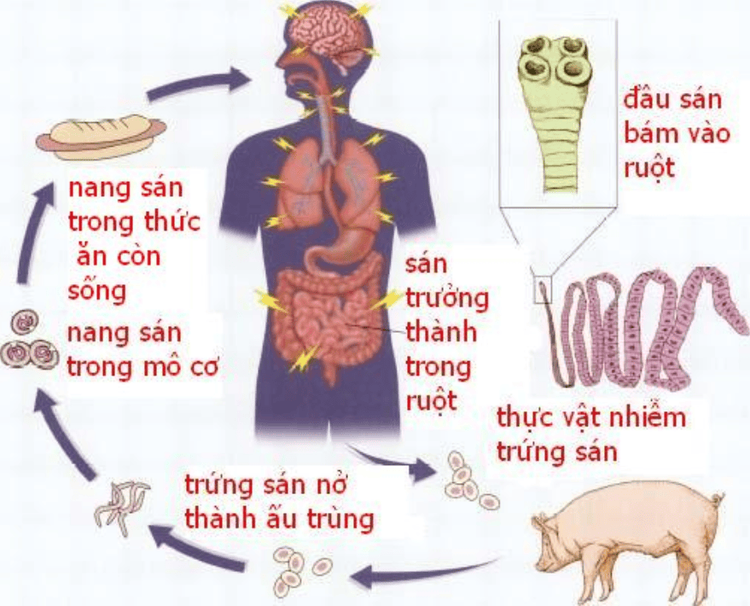
Cơ chế hoạt động của ấu trùng sán lợn gạo
4. What are the symptoms when I have a tapeworm infection?
Symptoms are often absent or not obvious. In general, helminthic diseases take up food when entering the body, leading to malabsorption, slow physical development, and digestive disorders.Stomachache; Digestive disorders: Anorexia, indigestion, erratic loose stools There are painless tumors about 1–2 cm under the skin and in the muscles (after many months or years these tumors turn to pain and swelling). then the swelling stops); Neurological symptoms such as weakness (if brain is affected); The tapeworm can be seen in the feces or crawling out of the anus, appearing in small, flat, ivory white segments. * Porkworm larvae are most dangerous when they attack the brain and heart, causing serious health effects and can leave complications. In case of eyeballs, it can cause glaucoma, decreased vision or blindness.
5. Can I get treatment for rice fluke completely?
5.1. Specific treatment Intestinal infections are treated with praziquantel 5 to 10 mg/kg orally as a single dose to eliminate adult worms. Praziquantel should be used with caution in patients with neurocysticercosis because by destroying the cyst, praziquantel may induce an inflammatory response associated with seizures or other symptoms.Alternatively, a single dose of niclosamide 2g (not available in the US) 4 tablets (500 mg each) is chewed once and swallowed with some water. For children, this dose is 50 mg/kg (up to 2 g) once.
5.2. Symptomatic-supportive treatment Depending on the location of the damaged organ to have appropriate treatment measures
6. Prevention of rice fluke disease
Actively prevent rice fluke infection by keeping the environment clean and managing waste well.Use clean water in daily life.
Wash hands often with soap before and after using the toilet, before cooking and eating, and clean the body.
In eating and drinking, it is necessary to eat and drink boiled; choose the source of pork origin, do not eat pork and pork products when not cooked such as blood pudding, spring rolls,..; Limit your intake of raw vegetables.
Strictly manage hygiene standards of pig slaughterhouses; Do not let pigs go free.
Targeted treatment for human tapeworm carriers.
Reduce transmission of schistosomiasis by educating the community about the transmission routes of the disease.
Rice fluke is a disease that can cause dangerous complications. It is necessary to be examined and treated promptly. Vinmec International General Hospital system with a team of qualified medical staff and state-of-the-art equipment is a reliable address for you to send your trust in healthcare.
Please dial HOTLINE for more information or register for an appointment HERE. Download MyVinmec app to make appointments faster and to manage your bookings easily.
Reference source: Department of Preventive Medicine - Ministry of Health




